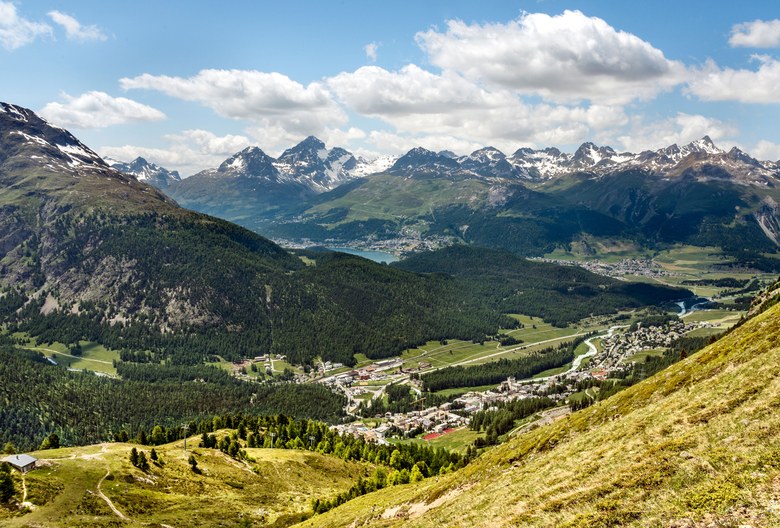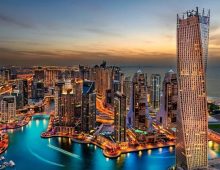When American tourists picture the Swiss Alps, they tend to picture luxe ski towns like Klosters, Verbier, and Zermatt. But just a few miles off the beaten path is an idyllic mountain village where everything—every view, every building, every bubbling pot of fondue—is so perfect, it makes your heart hurt. It’s a town of only 2,000 permanent residents tucked into the picturesque Engadine Valley, but tourism is its main industry, so excellent restaurants, cafés, hotels, and spas abound. The city’s tourists are primarily European, and Americans tend to favor nearby St. Moritz, a perfectly lovely mountain town just three miles up the road packed with ski-bunny celebs and designer shops. But Pontresina is well worth the visit for those who seek a smaller-town experience. Here, our guide to what to eat, see, and do in Switzerland’s hidden gem.

Photo: Getty Images
How to Get There
Most international visitors fly to Zurich and take the three-hour train ride to Pontresina—a scenic route past breathtaking lakes, peaks, and viaducts. You likely won’t need a car unless you’re staying for longer than a week or two, since Pontresina is walkable and laced with bus routes. If you prefer to drive, though, the town is three hours from both Zurich and Milan. In nearby Samedan, the tiny Engadin Airport caters to private jets and air taxis to nearby international airports.

Photo: Courtesy of Grand Hotel Kronenhof
Where to Stay
The town’s only five-star hotel, the Grand Hotel Kronenhof Pontresina, looks like something Wes Anderson dreamed up: Built in 1848 and still lavishly decorated in Belle Epoque style, it has the feel of an old palace with surprising nooks and corners to explore. If you can tear your gaze from its outrageous mountain views and beautifully woodworked guest rooms, enjoy a wander through Neo-Baroque ballrooms and lounges adorned with ceiling frescoes and glorious chandeliers, a speakeasy-like wine cellar, and even a nineteenth-century (still functional!) bowling alley.

Photo: Getty Images
Where to Eat
For brunch on a crisp, pine-scented morning, Alpine Cheese Dairy Morteratsch is a must: It’s a working farm where, in the summer and fall, visitors can graze on fresh eggs, cheese, bread, and fruit on picnic tables nestled in the grass between bumbling livestock and pine-covered hills. Guests are also treated to a live cheesemaking demonstration, and the patient cheesemongers will answer every one of your questions as you deliberate between dozens of fresh options on the buffet table. (Hint: Try them all.)
The atmospheric wine bar Gianottis caters to après-ski appetites with upscale dishes and masterfully grilled meats, along with house-made Swiss chocolate. Gourmands may prefer the cozy Kronenstübli, an award-winning restaurant with Swiss-pine paneling and original Engadine furniture. It’s known for its epic Canard à la Presse, a complex, traditional French preparation of duck.

Photo: Courtesy of Grand Hotel Kronenhof
What to Do
Relaxing in a spa is a necessary part of any Swiss holiday, and the 21,000-square-foot wellness center at the Kronenhof is renowned in the region; there’s an enormous indoor infinity pool with underwater speakers and eye-popping Alpine views, a separate spa pool with jets, a saltwater grotto, a labyrinth of steam rooms and saunas, and more. (Day passes are available for those not staying at the hotel.) The village’s outdoor Bellavita Pool & Spa, leaning out over a scenic mountainside, caters to families, with a waterslide and water playground alongside indoor and outdoor pools, saunas, and steam baths. (Don’t let the kiddie pool dissuade you; the entire complex exudes Swiss elegance, and the atmosphere is one of communal repose—not children shrieking.)
The Alps themselves are their own kind of playground, with hiking trails snaking across the valley and out toward eye-popping glaciers, plus a network of cable cars and chairlifts giving walkers an assist. Walking paths also fork out of the city center, past charming traditional houses and into thick woods and emerald hillsides (where, for a few months in spring, ibex blanket the landscape); another easy walk winds up to the charming Santa Maria Church, with its Byzantine-Romanesque frescoes, and the ruins of the circa-1200 Spaniola Castle.
One highly recommended mountain stroll: Start at Morteratsch Station (a few steps from the aforementioned dairy farm) and follow the flat trail past lacy waterfalls, braided hills, and a rushing river to the tongue of Morteratsch Glacier, the third largest in the Eastern Alps. The Engadine Valley is also equipped for mountain biking and climbing, plus all the usual winter fare: cross-country and downhill skiing, sledding, skating, and even ice climbing.












